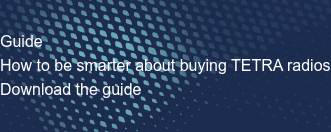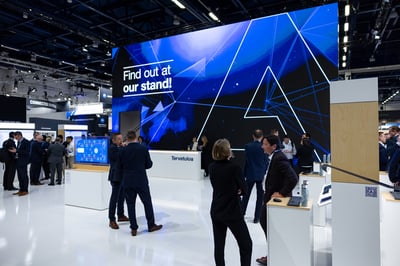What is your biggest challenge when buying TETRA radios? That's the question we put to our readers. People like you. Hundreds responded. Their answers are revealing.
It seems there are five top issues radio buyers face, from getting best value for money to ensuring total security. This post reveals how to solve these top five challenges.
Buying PMR radios can be a complex task. Even if you're an experienced equipment purchaser, you will need a great understanding of how your people perform their tasks and how they use radios. To deliver the capabilities users need every day, without fail, radios need to be specified accurately, put into operation properly and supported effectively.
Curious about what obstacles other buyers are up against? More than 400 of our readers told us about some of the common challenges they face. And we provide the solutions.
1 - How do you get value for money when choosing TETRA radios?
Let's start with a big one - one of the main priorities for professional buyers is to get the best value for money. Cost is of course a major factor, but picking the lowest priced product is all too often not the best decision.
Did you know that radios can cost more than the price on the ticket? If you are comparing the unit price of two radios, you need to check that they really are equivalent. It may sound like obvious advice, but comparing specifications needs a good eye for detail.
For example, does the radio work on your frequency? Does it have the correct TETRA Encryption Algorithm (TEA) and is Air Interface Encryption (AIE) activated? The truth is, without these, your radio will not connect to your network. You also need the right software to operate it, a battery and a charger to get it powered up. And don’t forget that all important item, an antenna.
You should also check that the functions you need, like GPS, are actually included. If the offered price includes only the radio unit, it may seem a bargain, but you will need to buy all the other items separately. The result could be a much higher final price than a “plug & play” radio package, with all the necessary stuff included.
Here’s how to make sure you spend your money well
Don’t fall into the trap of a low price if it doesn’t give you what you need – always check that it gives value for money.

You can download a handy Request for Proposals (RFP) guide, which explains what you need to know and the key questions you need to ask potential vendors. It will better equip you to compare the offers – not just the prices but the contents of the offers – and to identify the long-term, results-oriented partner who understands your challenges and has a solution to solve them.
2 - How do you combine TETRA and LTE for reliable voice and broadband?
In their daily work, many professional users already communicate by voice over PMR and use mobile broadband LTE networks. But it can be awkward and slow to use the two technologies because of the need to constantly switch between devices.
And it’s not just the sheer inconvenience of having to carry and use two devices. Batteries for several devices need to be charged, while separate earphones for two or three devices need to be carried. Organizations may also need to manage the users of both PMR and broadband networks separately – a task that could be enormously time consuming and expensive.
Readers gave us a list of issues they want solutions for. Here are some of the comments they made:
- Not having 3-4 different phones and radios at the same time
- To get TETRA+LTE radios with Android operating system
- Combining radio availability with strong app development platform
- Finding a handset that can offer mission-critical trunking services in both TETRA and LTE modes
- Finding radios which also can be used as a modern smartphone
- To get both narrowband and broadband technologies in one handset
- Limited data capabilities of 2-way radios.
Here’s how to find a radio that is more than just a voice device
Before deciding on PMR radios, ask potential vendors these questions:
- How does the device support both TETRA and LTE? If it doesn’t, how would they solve the problem of combining TETRA and LTE?
- How can they help you reduce the number of devices your users carry?
- How will the carried devices (for example cameras, sensors, video feed from a drone) be controlled? The best way would be through a single user interface and not separately.
- How can you make or bring apps to the device in a secure way?
- How are the users of both PMR and broadband networks managed – whether TETRA and LTE is combined or not? Every user individually? Or is there one system for managing subscribers over several networks, thus cutting the risk of mistakes.
- How are information security and personal data privacy (GDPR) ensured?
PMR is already moving towards combining the functions of a mission-critical radio and a smartphone. Given time, broadband networks and devices will support Mission-Critical Push-to-Talk (MCPTT).
However, a push-to-talk app such as Tactilon Agnet can already bring TETRA group communications to a smart device. There is also Tactilon Dabat – a rugged smartphone and TETRA radio in one, designed to meet the ergonomic needs of professional PTT use.
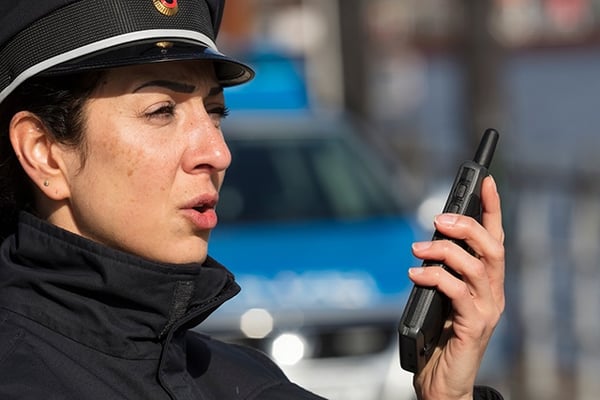
3 - How do you choose the right radio for your needs?
Today, there are tens of radios and hundreds more features to choose from, with many appearing very similar to each other. Sifting through this mass of information can be daunting. What should you be tracking? What actually matters? How do you decide which is the best for your organization’s needs?
Choosing the right radio is not as easy as it seems, making it the third biggest challenge for buyers. Some of the issues readers identified include:
- Finding the best in range and quality audio
- Finding the most suitable for us
- Finding the one with the specs and features I need
- Knowing which is the best
- The right one that meets the requirements.
Here’s how to buy the best TETRA radio on the market
In reality, getting the best radio depends on your needs, for example, what the end result should be. If you want to buy TETRA radios that work for you, it’s best not to write an RFP that reads like a technical specification and then evaluate the answers thinking “the bigger, the better”. Sure, it’s a logical, gut reaction - but not very helpful.
Why is this? It’s because biggest and most powerful is not always best. For example, a more powerful radio is not the best answer when you want more coverage and better communication.
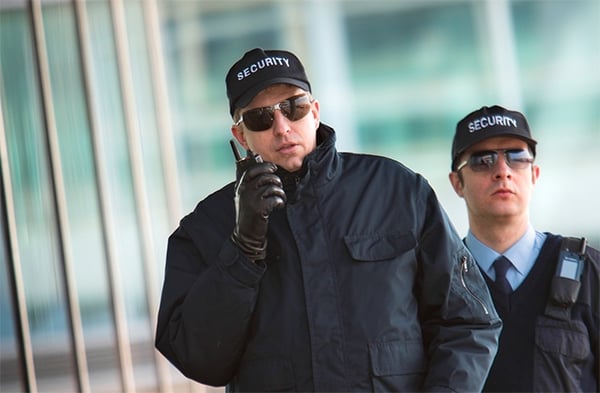
Instead, put together the key use cases and let the vendors explain how their offer will meet your needs.
But, using the radios is only one part of the story. When selecting a partner, be sure to look at your needs in these four phases:
- Buy, provision and parameterize the radios
- Bring the radios into use
- Use the radios
- Maintain and repair the radios.
4 - How do you explain fully and accurately what you need?
The most important part of an RFP is defining your needs and getting vendors to meet them. Usually, this step is the longest and can be overwhelming, even for the most experienced buyer.
How do you convey what you need without writing a novel? How do you communicate what you need so potential vendors will understand, particularly if you’re not technically minded?
At its best, a specification gives a bidding vendor all the information they need to offer a good proposal - at its worst, it can confuse and misguide, leading to poor proposals that don’t meet your needs.
Here’s how to write a good TETRA radio RFP
Before you get started on crafting your RFP, take a long hard look at your organization’s real radio communication needs. This helps you define what you want from the radios – after all, the radios you purchase should help people work more effectively.
When it comes time to put pen to paper, start with a clear goal in mind. Don’t be distracted from this goal.
If you are uncertain about what you want or why you want it, don’t be tempted to just put down everything you can think of. Above all, avoid a long list of requirements or too many technical details, especially if this is not your organization’s area of expertise.
For example, does it really make sense to repeat all the TETRA interoperability requirements in your radio RFP? It is important to require interoperability because it means that you can choose more than just one vendor’s radios. However, it should be enough to require that the radios have been certified in your network vendor's interoperability (IOP) tests.
5 - How do you ensure total security?
Organizations that undertake critical missions need total security for their professional communications – from radio to radio and at every stage in between.
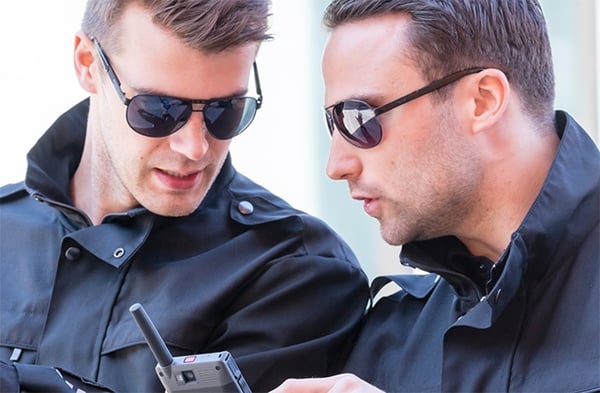
But how do you make sure the radios you purchase are truly secure? There’s secure and then there’s secure - which one did the vendor mean when they sold you the radios? Do they really meet your security needs? Security has many aspects and it’s easy for a supplier to tick the security box without supplying what you really need.
Here’s how to get the security you need
Security is the sum of many different elements – it’s not just about the availability, or end-to-end encryption, nor any other single aspect.
A good radio will provide the ultimate protection for the most sensitive information, such as suspect descriptions, driving plate information, patient data/medical conditions and many others. Following the introduction of the new GDPR regulations in Europe, data protection is a hot topic for most organizations.
While air interface encryption is common in digital radio communication systems, consider end-to-end security from radio to radio. End-to-end encryption provides ultimate protection for the most sensitive information, even within user organizations.
Do the offered radios support end-to-end encryption? If not, can you upgrade the radios later to support it? Will it require hardware changes to the radios, or can it be introduced without calling the radios back to the maintenance center?
And make sure you have the ultimate control – that you can apply your own encryption as well as implement the solution yourself to meet your own needs.
Learn to write your radio RFP/RFQ so you get what you really need - Download this eBook:
Many of our readers have gone through the process of choosing professional radios before. By following these tips, you can benefit from their experience and get the radios that will serve you well for years to come.

